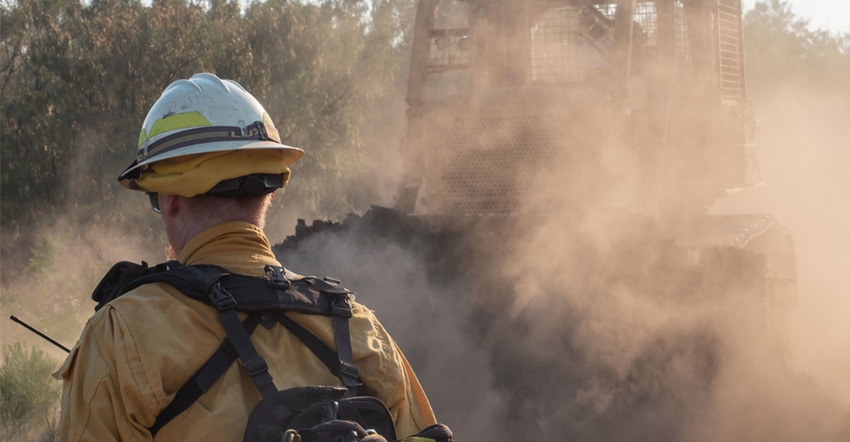August 28, 2020

The return of triple-digit temperatures Aug. 28-30 will increase the rate of drying in vegetation, resulting in an increased risk of wildland fires. Minimal rainfall was received from Hurricane Laura west of Interstate 35, where dangerously dry fuels are present.
Despite the impact of Hurricane Laura to the eastern portion of the state, most of Texas will continue to see hot and dry conditions. Texas A&M Forest Service encourages Texans to remain vigilant and cautious with activities that may cause a spark and ignite a wildfire.
“The potential for increased fire activity Aug. 28-30 is high generally west of Interstate 35, from Fort Worth to San Antonio,” said Luke Kanclerz, Texas A&M Forest Service fire analyst. “Even after periods of short duration rainfall, underlying drought and temperatures forecast over 100 degrees will allow vegetation to lose moisture at a high rate and rebound back to being critically dry.”
Fire environment—weather, fuels and current conditions
It does not take much change in fire weather conditions, such as increased wind speeds, low humidity levels and extreme temperatures, to cause more fires to occur when potential fuels are critically dry.
These wildfires may also be more resistant to firefighters’ suppression efforts.
“Critically dry fuel beds are more receptive to wildland fire ignitions,” said Kanclerz. “The potential for large or significant fires may increase Sunday as winds are forecast to increase near 15 mph west of the Interstate 35 corridor.”
For current conditions and wildfire outlook, go to the Texas Fire Potential Outlook.
Fire activity
Due to significant fire activity occurring in multiple geographic areas across the country and heavy commitment of shared resources to large fires nationally, the National Multi Agency Coordinating Group has raised the National Preparedness Level to Level 5.
Preparedness levels are dictated by fuel and weather conditions, fire activity and fire suppression resource availability throughout the country. Level 5 is the highest level of wildland fire activity and indicates heavy resource commitment to fires nationally. The state of Texas is currently at a Level 4, with increased resource commitment and wildfire activity statewide.
In addition to continued wildfire response across the state, Texas A&M Forest Service personnel are currently assisting with Hurricane Laura response efforts. Forty-five personnel are providing planning and logistical support to the Texas Division of Emergency Management. More resources are staged and ready to respond for debris removal and additional support in areas affected by the hurricane.
Over the past week, state and local resources have responded to 90 fires that have burned 7,619 acres. These include many large, multi-day fires such as the still-smoldering Comanche Creek Fire in Blanco County. That fire has now burned 406 acres and is 95% contained.
Many of the recent wildfire starts have been attributed to human activities—such as equipment use and debris burning—and are preventable.
Aviation resources continue to assist ground crews with suppression efforts by coordinating water and retardant drops to slow fire progression. Fire suppression aircraft have logged approximately 117 hours of flight time over the past week.
Efforts involved dropping 31,620 gallons of water and 31,800 gallons of retardant on multiple fires including the Comanche Creek Fire; Owens Fire in Reagan County, which burned 897 acres and is 100% contained; 8889 Fire in Ward County, which burned 1,309 acres and is 100% contained; and the North Coats Fire in Crockett County, which burned 315 acres and is 100% contained.
Aviation resources staged in state include two Type 1 helicopters, two Type 3 helicopters, 14 single- engine air tankers and two air attack platforms.
Since Jan. 1, state and local resources have responded to 3,913 fires that have burned a total of 194,969 acres. So far this year, aviation resources have flown 1,950 hours, dropping 1,926,747 gallons of water and retardant on Texas wildfires.
If a wildfire is spotted, contact local authorities immediately. A quick response can help save lives and property.
For frequent wildfire and incident updates, follow the Texas A&M Forest Service incident information Twitter account.
Prevention and Mitigation
Hunting season is here and with continued hot, dry, windy weather conditions. This means an extra level of awareness and safety is required.
Hunters and outdoor enthusiasts should use caution in the field and be mindful of activities that may cause a wildfire. These include:
Avoiding shooting near tall, dry grass or rocks and avoid using full metal jacket or tracer ammunition.
Maintaining off-road vehicles and avoid parking or idling over dry vegetation.
If towing a trailer, securing safety chains to ensure they will not come in contact with the road as that can creates sparks.
Checking with local officials for burn bans or other outdoor burning restrictions.
Residents should also pay attention to county burn bans and avoid all outdoor burning until conditions improve. Burn ban information can be found by contacting local fire departments or by visiting Texas Burn Bans.
For media resources, including public service announcements, posters and audio and video files, visit the TFS Media Resources page.
Source: is AgriLife TODAY, which is solely responsible for the information provided and is wholly owned by the source. Informa Business Media and all its subsidiaries are not responsible for any of the content contained in this information asset.
Read more about:
WildfiresYou May Also Like




